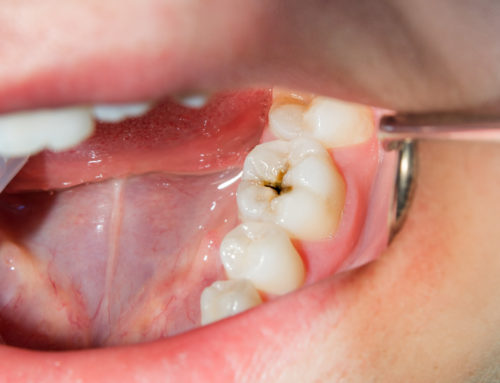Dental decay is surprisingly common, with about 92 percent of adults experiencing cavities at least once in life. But while most of us have had a dental filling, we often know less about the much-maligned root canal procedure!
This can make it hard to tell when we need a simple filling or the more intensive root canal procedure. But what is a root canal, anyway, and how is it different from a common filling? Here’s what you should know about both procedures, and how to tell when you need them.
What’s the Difference Between a Filling and a Root Canal?
Fillings and root canals have several things in common, but it’s helpful to know the difference if you think you may need one or the other. Here’s what to expect from each:
Tooth Filling
We often recommend dental fillings when a patient has a cavity or minor tooth decay. However, this is only true as long as these issues haven’t reached the pulp of the tooth or the connective tissues that sit in the center of the tooth. We also recommend them for small tooth fractures.
With a tooth filling, we’ll clean out any cavity and then fill the hole (or imperfection, in case of a fracture) with composite resin. This prevents the issue from worsening later, causing you more pain and dental issues.
Root Canal
You might hear root canals called “endodontic therapy” as well. A root canal is recommended once tooth decay has become serious enough to reach the tooth pulp, especially once an infection has set in.
Root canals may be needed for more severe, untreated cavities—which is why we tell patients to come in for regular check-ups!
With a root canal procedure, your dentist will remove the pulp of your tooth to rid you of the infection. Then, they’ll follow up by placing a dental crown.
Many of our patients ask, “Do root canals hurt?” While root canals have a bad rap for being the worst procedure your mouth can endure, our answer is, “A lot less than you’d think!”
In fact, one 2011 review of 72 studies found that only 17 percent of people thought a root canal was the worst dental procedure they’d experienced. A root canal can be described as a more in-depth version of a filling, and with local anesthesia to numb the area, you should feel pressure instead of root canal pain during the procedure.
Signs You Need a Filling
With more minor symptoms, you may only need a simple dental filling. However, you must get the issue taken care of as soon as possible—before eventual infection requires a root canal. Here are the signs to look for:
Dark Spots or Holes
Cavities attack the tooth in a way that (as the name suggests) may leave an actual hole or dark spot on the tooth. If your cavity is positioned so you can see it in a mirror, you may notice a tiny discoloration or hole on your tooth.
You may even notice that food always gets stuck between certain teeth, as it settles into the hole created by your cavity. Your floss may consistently tear in a certain spot as well, hooked on part of the cavity.
Fractured Teeth
Usually, people come in for dental fillings when they have a cavity, but that’s not the only reason. Fillings are a great way to take care of tooth fractures as well, as they prevent further tooth damage.
Signs You Need a Root Canal
When the decay has extended to the pulp of your tooth, you’ll need a root canal to solve the problem. But how can you tell when that’s the case? Here are the signs to look out for:
Sensitivity to Temperature
If your tooth hurts when you drink coffee or eat ice cream, it may be an indication of a more severe cavity. This happens when the blood vessels in the tooth are infected.
Depending on the severity of the issue, your tooth sensitivity may radiate into a dull ache or sharp pain, and it may linger for some time even after eating.
Tooth Discoloration
Tooth discoloration can have other causes as well, but when it occurs with just a single tooth, it’s often a sign that infection has set in in the pulp of the tooth. This infection can damage the tooth’s roots, break down tissue, weaken the blood supply, and give the tooth an unsightly gray appearance.
Swollen Gums
If your gums are swollen around one particular tooth, it may be a sign of infection. This is true whether or not the swelling or redness feels painful when you touch it.
Pain When You Touch the Tooth
One of the classic signs you may need a root canal is a pain when you touch the tooth. The sensitivity to touch may extend to chewing as well, and it may not go away even when you stop eating.
A Loose Tooth
Once an infection has set in, your tooth may start to feel looser. Pulpal necrosis, or death of the nerve cells of the tooth, can in turn soften the bone around your tooth.
Signs Common to Both Conditions
Unfortunately, there are a few symptoms that are a little harder to diagnose. These symptoms might require either a root canal or a dental filling—or something else entirely. If you’re seeing any of the symptoms below, you’ll need to come in for an expert check.
Tooth Pain
Tooth pain is one of the most common complaints we hear from our patients. However, tooth pain can be the result of many things, from a simple cavity to teeth grinding to infection.
However, the severity of the pain may help you tell what kind of procedure you’ll need. When you need dental fillings, you may have a throbbing pain in your tooth, especially when you chew. When you need a root canal, the pain can be much more severe, and that pain may worsen when your tooth is exposed to hot or cold temperatures.
Foul Breath and Taste
Food particles that wedge themselves into a cavity can cause bad breath, and that’s true for both small and large cavities. These food particles can create bacteria that contribute to bad breath, or simply a bad taste in your mouth.
Get an Expert Opinion
If you’re experiencing pain, tooth sensitivity, or any of the symptoms above, you don’t have to figure the next steps out alone—whether that means a filling or a root canal. Understanding your symptoms can help you have a little more peace of mind around what the most likely procedure will be, but we can help you understand what’s going on with your teeth and recommend the best way forward.
Reach out to our helpful team for a check-up with no pressure, fear, or judgment. We’ll discuss your options and help you find the oral health plan that works for you!




